check engine YAMAHA GP1800R SVHO 2022 User Guide
[x] Cancel search | Manufacturer: YAMAHA, Model Year: 2022, Model line: GP1800R SVHO, Model: YAMAHA GP1800R SVHO 2022Pages: 112, PDF Size: 4.91 MB
Page 65 of 112
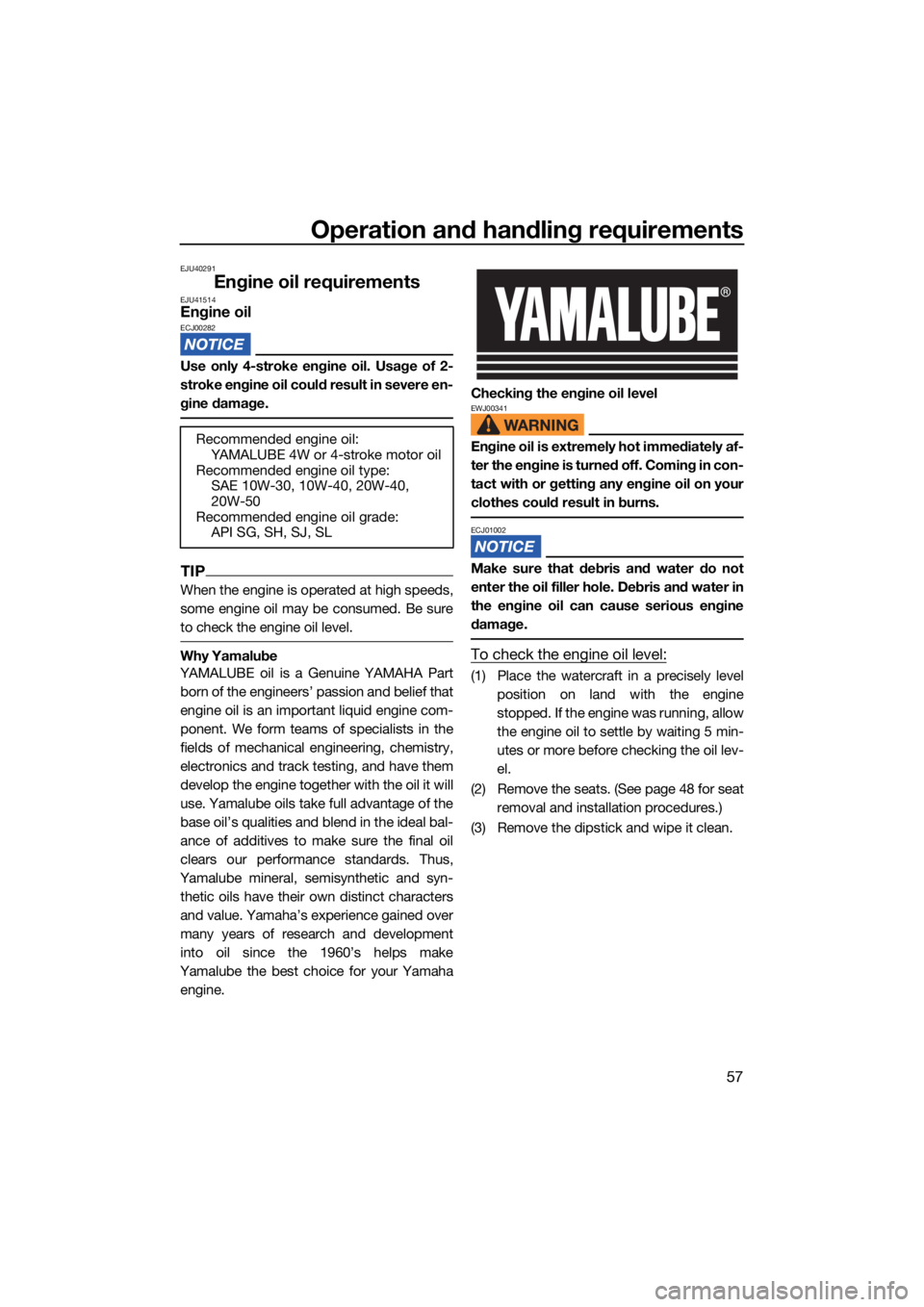
Operation and handling requirements
57
EJU40291
Engine oil requirementsEJU41514Engine oilECJ00282
Use only 4-stroke engine oil. Usage of 2-
stroke engine oil could result in severe en-
gine damage.
TIP
When the engine is operated at high speeds,
some engine oil may be consumed. Be sure
to check the engine oil level.
Why Yamalube
YAMALUBE oil is a Genuine YAMAHA Part
born of the engineers’ passion and belief that
engine oil is an important liquid engine com-
ponent. We form teams of specialists in the
fields of mechanical engineering, chemistry,
electronics and track testing, and have them
develop the engine together with the oil it will
use. Yamalube oils take full advantage of the
base oil’s qualities and blend in the ideal bal-
ance of additives to make sure the final oil
clears our performance standards. Thus,
Yamalube mineral, semisynthetic and syn- thetic oils have their own distinct characters
and value. Yamaha’s experience gained over
many years of research and development
into oil since the 1960’s helps make
Yamalube the best choice for your Yamaha engine. Checking the engine oil level
EWJ00341
Engine oil is extremely hot immediately af-
ter the engine is turned off. Coming in con-
tact with or getting any engine oil on your
clothes could result in burns.
ECJ01002
Make sure that debris and water do not
enter the oil filler hole. Debris and water in
the engine oil can cause serious engine
damage.
To check the engine oil level:
(1) Place the watercraft in a precisely level
position on land with the engine
stopped. If the engine was running, allow
the engine oil to settle by waiting 5 min-
utes or more before checking the oil lev-
el.
(2) Remove the seats. (See page 48 for seat removal and installation procedures.)
(3) Remove the dipstick and wipe it clean.
Recommended engine oil:
YAMALUBE 4W or 4-stroke motor oil
Recommended engine oil type: SAE 10W-30, 10W-40, 20W-40,
20W-50
Recommended engine oil grade: API SG, SH, SJ, SL
UF4P72E0.book Page 57 Tuesday, August 24, 2021 3:18 PM
Page 66 of 112

Operation and handling requirements
58
(4) Insert the dipstick back into the dipsticktube completely. Remove the dipstick
again and make sure that the engine oil
level is between the minimum and maxi-
mum level marks.
(5) If the engine oil level is significantly above the maximum level mark, consult
a Yamaha dealer. If the engine oil level is
below the minimum level mark, add en-
gine oil.
(6) Loosen the engine oil filler cap and re- move it. (7) Slowly add engine oil.
TIP
The difference between the minimum and
maximum level marks on the dipstick is equal
to approximately 1 L (1.06 US qt, 0.88 Imp.qt)
of engine oil.
(8) Wait approximately 5 minutes to allow
the engine oil to settle, and then check
the engine oil level again.
(9) Repeat steps 3–8 until the engine oil is at the proper level.
(10) Securely install the engine oil filler cap by tightening it until it stops.
(11) Securely install the seats in their original positions.
1Dipstick
1 Maximum level mark
2 Minimum level mark
1
1
2
1Engine oil filler cap
1
UF4P72E0.book Page 58 Tuesday, August 24, 2021 3:18 PM
Page 67 of 112
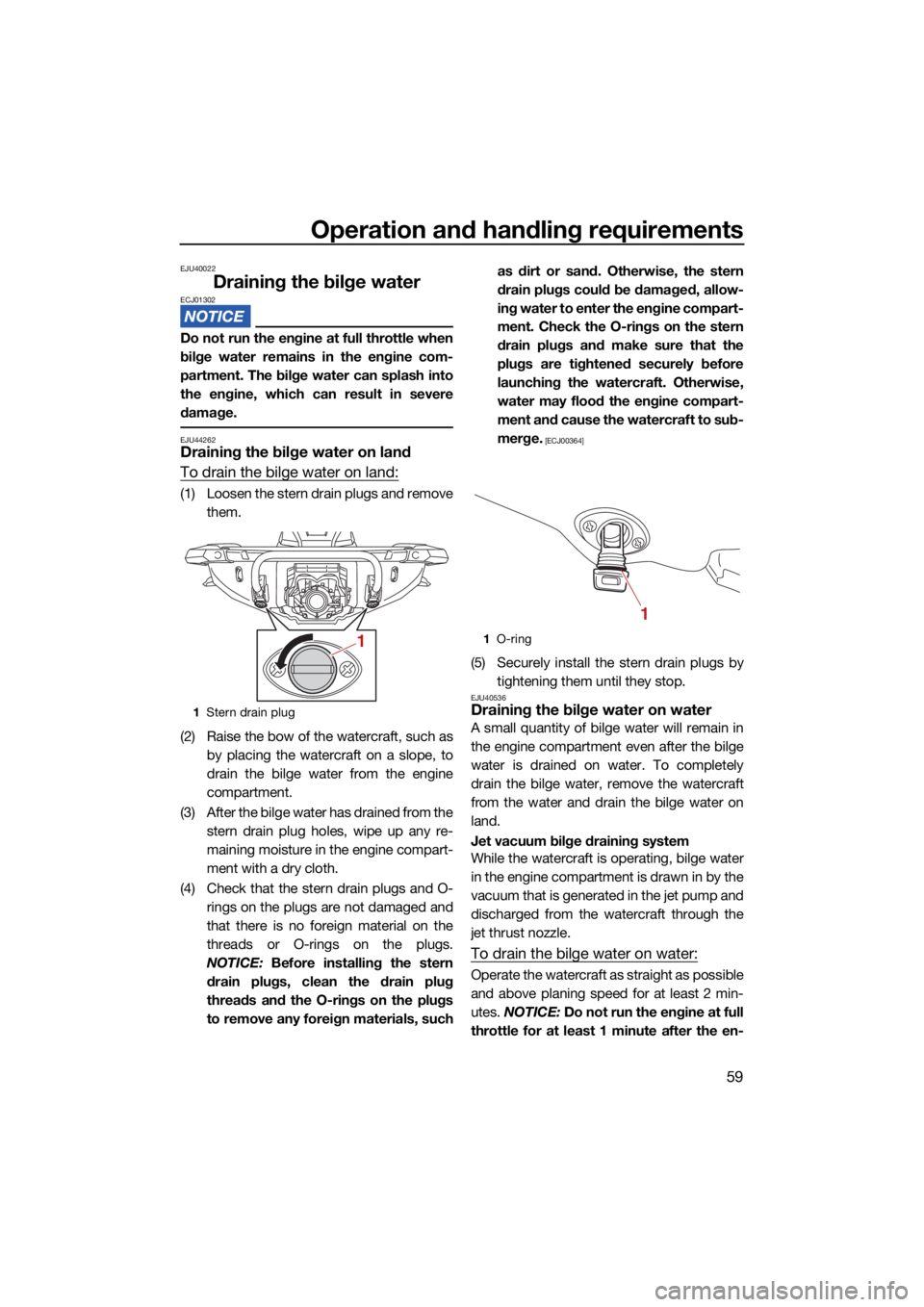
Operation and handling requirements
59
EJU40022
Draining the bilge waterECJ01302
Do not run the engine at full throttle when
bilge water remains in the engine com-
partment. The bilge water can splash into
the engine, which can result in severe
damage.
EJU44262Draining the bilge water on land
To drain the bilge water on land:
(1) Loosen the stern drain plugs and removethem.
(2) Raise the bow of the watercraft, such as by placing the watercraft on a slope, to
drain the bilge water from the engine
compartment.
(3) After the bilge water has drained from the stern drain plug holes, wipe up any re-
maining moisture in the engine compart-
ment with a dry cloth.
(4) Check that the stern drain plugs and O- rings on the plugs are not damaged and
that there is no foreign material on the
threads or O-rings on the plugs.
NOTICE: Before installing the stern
drain plugs, clean the drain plug
threads and the O-rings on the plugs
to remove any foreign materials, such as dirt or sand. Otherwise, the stern
drain plugs could be damaged, allow-
ing water to enter the engine compart-
ment. Check the O-rings on the stern
drain plugs and make sure that the
plugs are tightened securely before
launching the watercraft. Otherwise,
water may flood the engine compart-
ment and cause the watercraft to sub-
merge.
[ECJ00364]
(5) Securely install the stern drain plugs by
tightening them until they stop.
EJU40536Draining the bilge water on water
A small quantity of bilge water will remain in
the engine compartment even after the bilge
water is drained on water. To completely
drain the bilge water, remove the watercraft
from the water and drain the bilge water on
land.
Jet vacuum bilge draining system
While the watercraft is operating, bilge water
in the engine compartment is drawn in by the
vacuum that is generated in the jet pump and
discharged from the watercraft through the
jet thrust nozzle.
To drain the bilge water on water:
Operate the watercraft as straight as possible
and above planing speed for at least 2 min-
utes. NOTICE: Do not run the engine at full
throttle for at least 1 minute after the en-
1 Stern drain plug
11O-ring
1
UF4P72E0.book Page 59 Tuesday, August 24, 2021 3:18 PM
Page 69 of 112

First-time operation
61
EJU42690
Engine break-inECJ00432
Failure to perform the engine break-in
could result in reduced engine life or even
severe engine damage.
The engine break-in is essential to allow the
various components of the engine to wear
and polish themselves to the correct operat-
ing clearances. This ensures proper perfor-
mance and promotes longer component life.
To perform the engine break-in:
(1) Check the engine oil level. (See page 57for information on checking the engine
oil level.)
(2) Launch the watercraft and start the en- gine. (See page 72 for information on
starting the engine.)
(3) For the first 5 minutes, operate with the engine speed at 2000 r/min.
(4) For the next 90 minutes, operate with the engine speed below 5000 r/min.
After the engine break-in is complete, the wa-
tercraft can be operated normally.
UF4P72E0.book Page 61 Tuesday, August 24, 2021 3:18 PM
Page 70 of 112

Pre-operation checks
62
EJU31984
EWJ00413
Failure to inspect or maintain the watercraft properly increases the possibility of an ac-
cident or damage to the watercraft. Do not operate the watercraft if you find any prob-
lem. If a problem cannot be corrected by the procedures provided in this manual, have
the watercraft inspected by a Yamaha dealer.
EJU41237Pre-operation checklist
Before using this watercraft, be sure to perform the checks in the following checklist.
PRE-LAUNCH CHECKS
ITEM ROUTINEPAGE
Engine compartment Ventilate the engine compartment.
Check inside the engine compartment for damage.
64
Fuel system Check the fuel system for leakage.
Check the fuel level in the fuel tank.
64
Water separator Check the water separator for water. 64
Engine unit Check the exterior of the engine unit for damage. 65
Engine oil level Check the engine oil level. 65
Bilge water Check the engine compartment for bilge water. 65
Battery Check the battery connections. 65
Steering system Check the steering system for proper operation. 65
Adjustable tilt steering sys-
tem Check the adjustable tilt steering system for proper
operation and check that the handlebars are se-
curely locked in place.
66
RiDE lever Check the RiDE lever for proper operation. 66
Throttle lever Check the throttle lever for proper operation. 66
Yamaha Security System Check the Yamaha Security System for proper op-
eration.
67
Engine shut-off cord (lan-
yard) Check the engine shut-off cord (lanyard) for dam-
age.
67
Switches Check the engine start/stop switch and engine
shut-off switch for proper operation.
67
Electric trim system Check the electric trim system for proper operation. 68
Storage compartments Check the storage compartments for damage and
water.
68
Fire extinguisher holder,
cover, and band Check the fire extinguisher holder, cover, and band
for damage.
68
Fire extinguisher Check the condition of the fire extinguisher. 68
Safety equipment Check that safety equipment meeting the applica-
ble regulations is on board.
68
Hull and deck Check the hull and deck for damage. 68
Jet intake Check the jet intake for damage and clogging. 68
UF4P72E0.book Page 62 Tuesday, August 24, 2021 3:18 PM
Page 71 of 112

Pre-operation checks
63
POST-LAUNCH CHECKS
TIP
To ensure safety and reliability, pre-operation checks should be made each time the water-
craft is used.
Jet thrust nozzle and re-
verse gate Check the jet thrust nozzle and reverse gate for
damage.
68
Stern drain plugs Check the stern drain plugs for damage and foreign
material and check that they are securely installed.
69
Hood Check that the hood is securely closed. 69
Front and rear seats Check that the seats are securely installed. 48
ITEM ROUTINE PAGE
Cooling water pilot outlet Check that water is discharged from the port (left)
cooling water pilot outlet while the engine is run-
ning. 69
Multifunction information
center Check the multifunction information center for prop-
er operation.
70
Shift system Check the shift system for proper operation. 70
Engine idling speed Check the engine idling speed. 70
ITEM ROUTINE PAGE
UF4P72E0.book Page 63 Tuesday, August 24, 2021 3:18 PM
Page 72 of 112
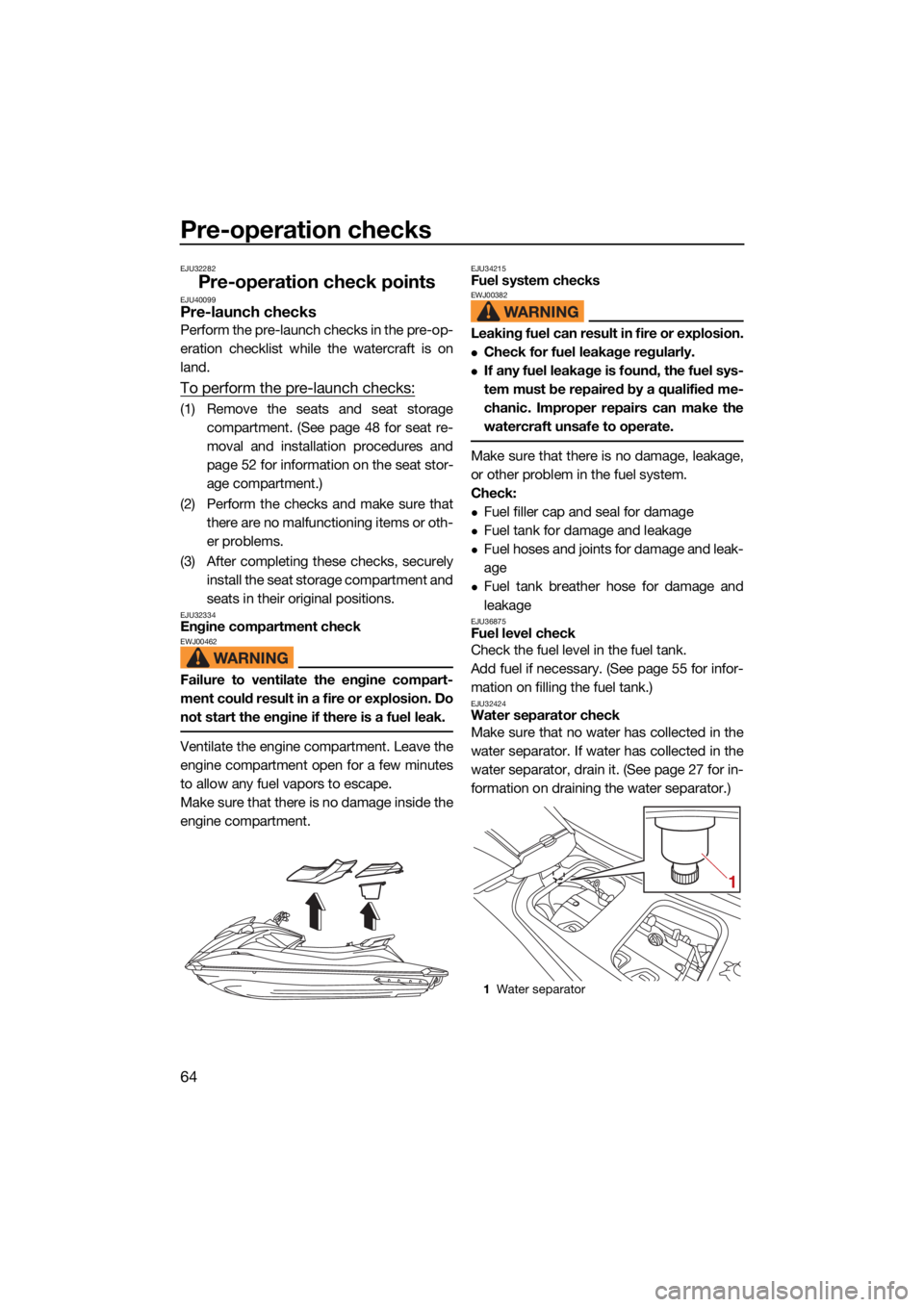
Pre-operation checks
64
EJU32282
Pre-operation check pointsEJU40099Pre-launch checks
Perform the pre-launch checks in the pre-op-
eration checklist while the watercraft is on
land.
To perform the pre-launch checks:
(1) Remove the seats and seat storagecompartment. (See page 48 for seat re-
moval and installation procedures and
page 52 for information on the seat stor-
age compartment.)
(2) Perform the checks and make sure that there are no malfunctioning items or oth-
er problems.
(3) After completing these checks, securely install the seat storage compartment and
seats in their original positions.
EJU32334Engine compartment checkEWJ00462
Failure to ventilate the engine compart-
ment could result in a fire or explosion. Do
not start the engine if there is a fuel leak.
Ventilate the engine compartment. Leave the
engine compartment open for a few minutes
to allow any fuel vapors to escape.
Make sure that there is no damage inside the
engine compartment.
EJU34215Fuel system checksEWJ00382
Leaking fuel can result in fire or explosion.
Check for fuel leakage regularly.
If any fuel leakage is found, the fuel sys-
tem must be repaired by a qualified me-
chanic. Improper repairs can make the
watercraft unsafe to operate.
Make sure that there is no damage, leakage,
or other problem in the fuel system.
Check:
Fuel filler cap and seal for damage
Fuel tank for damage and leakage
Fuel hoses and joints for damage and leak-
age
Fuel tank breather hose for damage and
leakage
EJU36875Fuel level check
Check the fuel level in the fuel tank.
Add fuel if necessary. (See page 55 for infor-
mation on filling the fuel tank.)
EJU32424Water separator check
Make sure that no water has collected in the
water separator. If water has collected in the
water separator, drain it. (See page 27 for in-
formation on draining the water separator.)
1Water separator
1
UF4P72E0.book Page 64 Tuesday, August 24, 2021 3:18 PM
Page 73 of 112
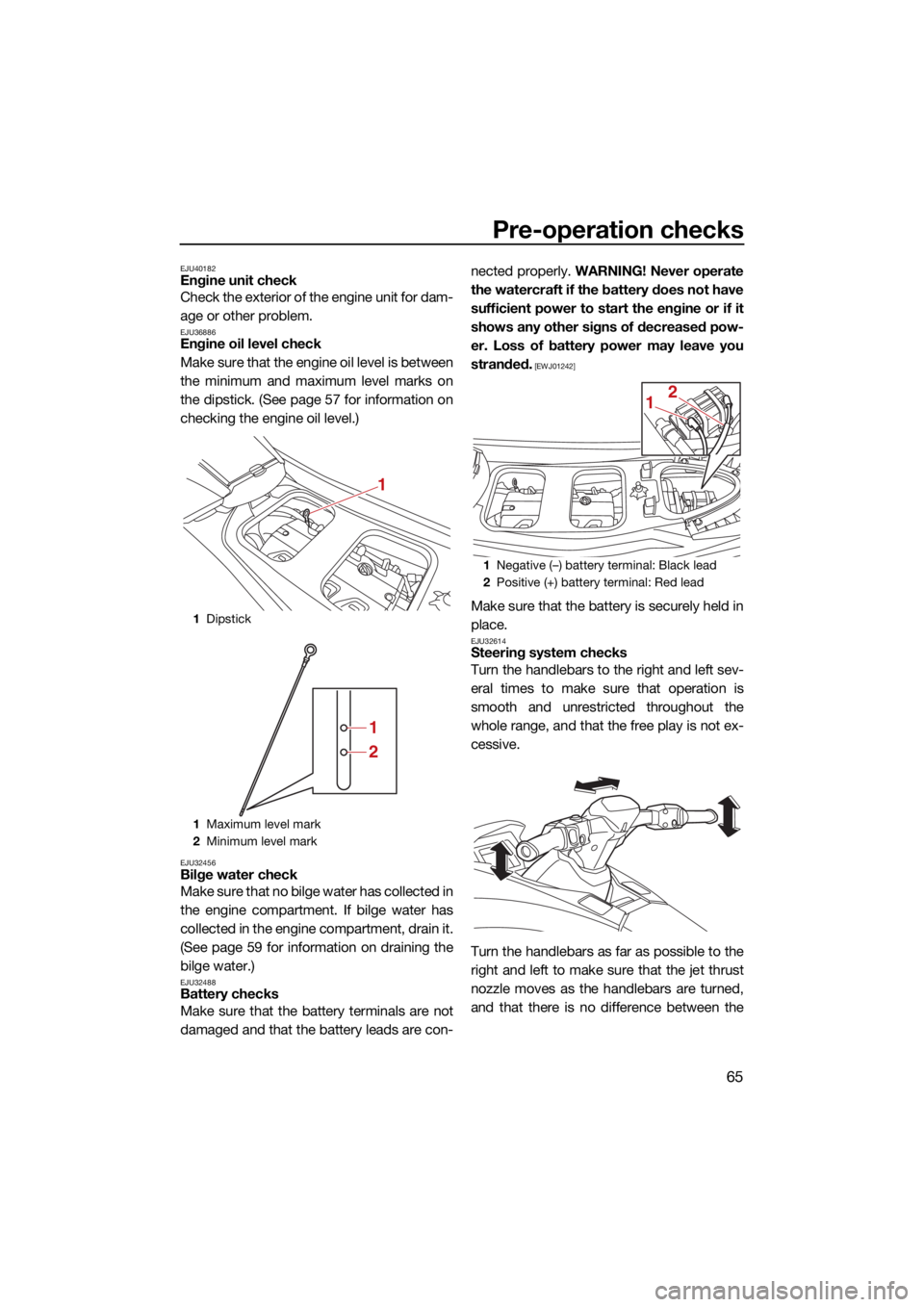
Pre-operation checks
65
EJU40182Engine unit check
Check the exterior of the engine unit for dam-
age or other problem.
EJU36886Engine oil level check
Make sure that the engine oil level is between
the minimum and maximum level marks on
the dipstick. (See page 57 for information on
checking the engine oil level.)
EJU32456Bilge water check
Make sure that no bilge water has collected in
the engine compartment. If bilge water has
collected in the engine compartment, drain it.
(See page 59 for information on draining the
bilge water.)
EJU32488Battery checks
Make sure that the battery terminals are not
damaged and that the battery leads are con-nected properly.
WARNING! Never operate
the watercraft if the battery does not have
sufficient power to start the engine or if it
shows any other signs of decreased pow-
er. Loss of battery power may leave you
stranded.
[EWJ01242]
Make sure that the battery is securely held in
place.
EJU32614Steering system checks
Turn the handlebars to the right and left sev-
eral times to make sure that operation is
smooth and unrestricted throughout the
whole range, and that the free play is not ex-
cessive.
Turn the handlebars as far as possible to the
right and left to make sure that the jet thrust
nozzle moves as the handlebars are turned,
and that there is no difference between the
1 Dipstick
1 Maximum level mark
2 Minimum level mark
1
1
2
1Negative (–) battery terminal: Black lead
2 Positive (+) battery terminal: Red lead
2
1
UF4P72E0.book Page 65 Tuesday, August 24, 2021 3:18 PM
Page 75 of 112
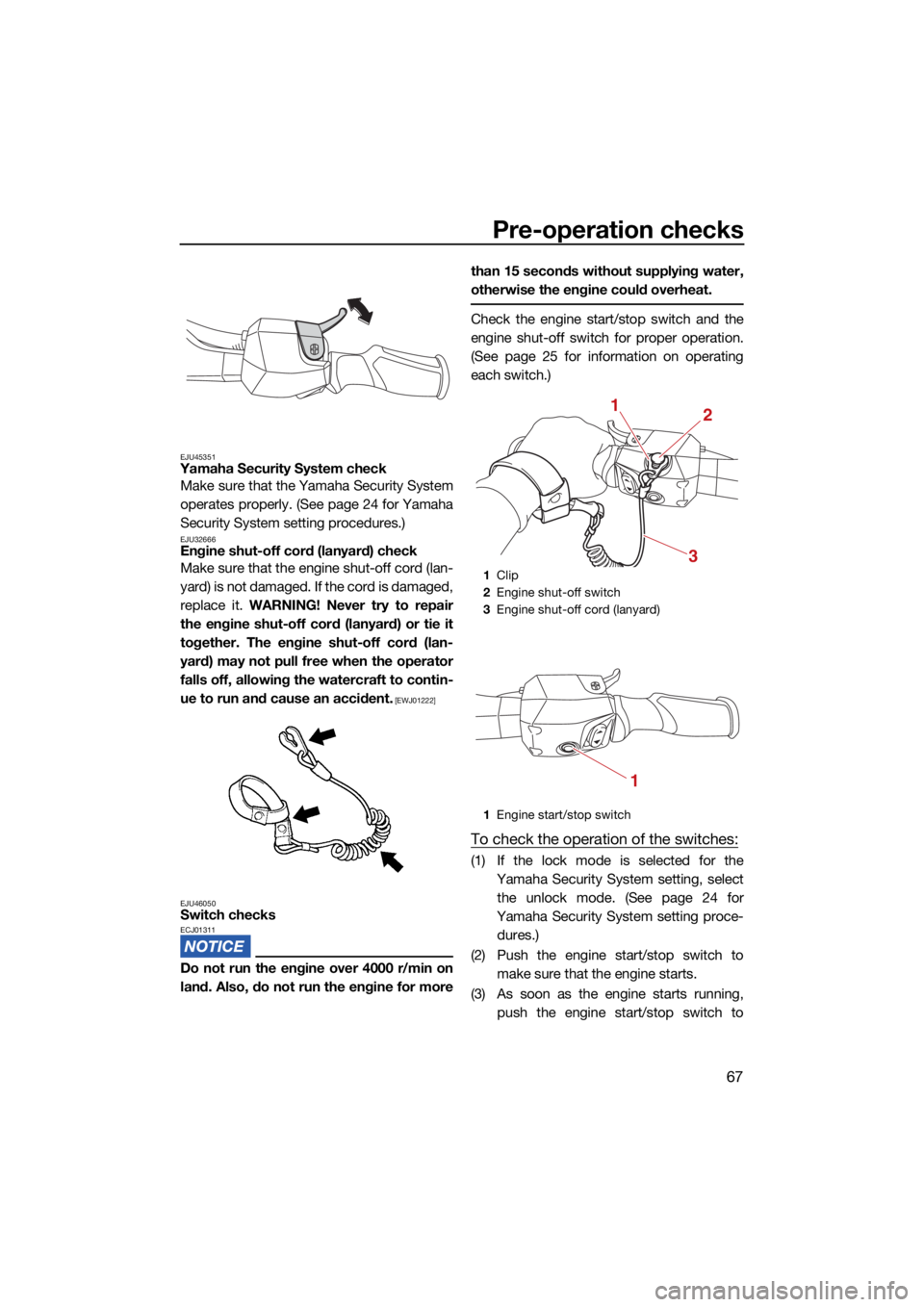
Pre-operation checks
67
EJU45351Yamaha Security System checkMake sure that the Yamaha Security System
operates properly. (See page 24 for Yamaha
Security System setting procedures.)
EJU32666Engine shut-off cord (lanyard) check
Make sure that the engine shut-off cord (lan-
yard) is not damaged. If the cord is damaged,
replace it. WARNING! Never try to repair
the engine shut-off cord (lanyard) or tie it
together. The engine shut-off cord (lan-
yard) may not pull free when the operator
falls off, allowing the watercraft to contin-
ue to run and cause an accident.
[EWJ01222]
EJU46050
Switch checksECJ01311
Do not run the engine over 4000 r/min on
land. Also, do not run the engine for more than 15 seconds without supplying water,
otherwise the engine could overheat.
Check the engine start/stop switch and the
engine shut-off switch for proper operation.
(See page 25 for information on operating
each switch.)
To check the operation of the switches:
(1) If the lock mode is selected for the
Yamaha Security System setting, selectthe unlock mode. (See page 24 for
Yamaha Security System setting proce- dures.)
(2) Push the engine start/stop switch to make sure that the engine starts.
(3) As soon as the engine starts running, push the engine start/stop switch to
1Clip
2 Engine shut-off switch
3 Engine shut-off cord (lanyard)
1 Engine start/stop switch
12
3
1
UF4P72E0.book Page 67 Tuesday, August 24, 2021 3:18 PM
Page 76 of 112
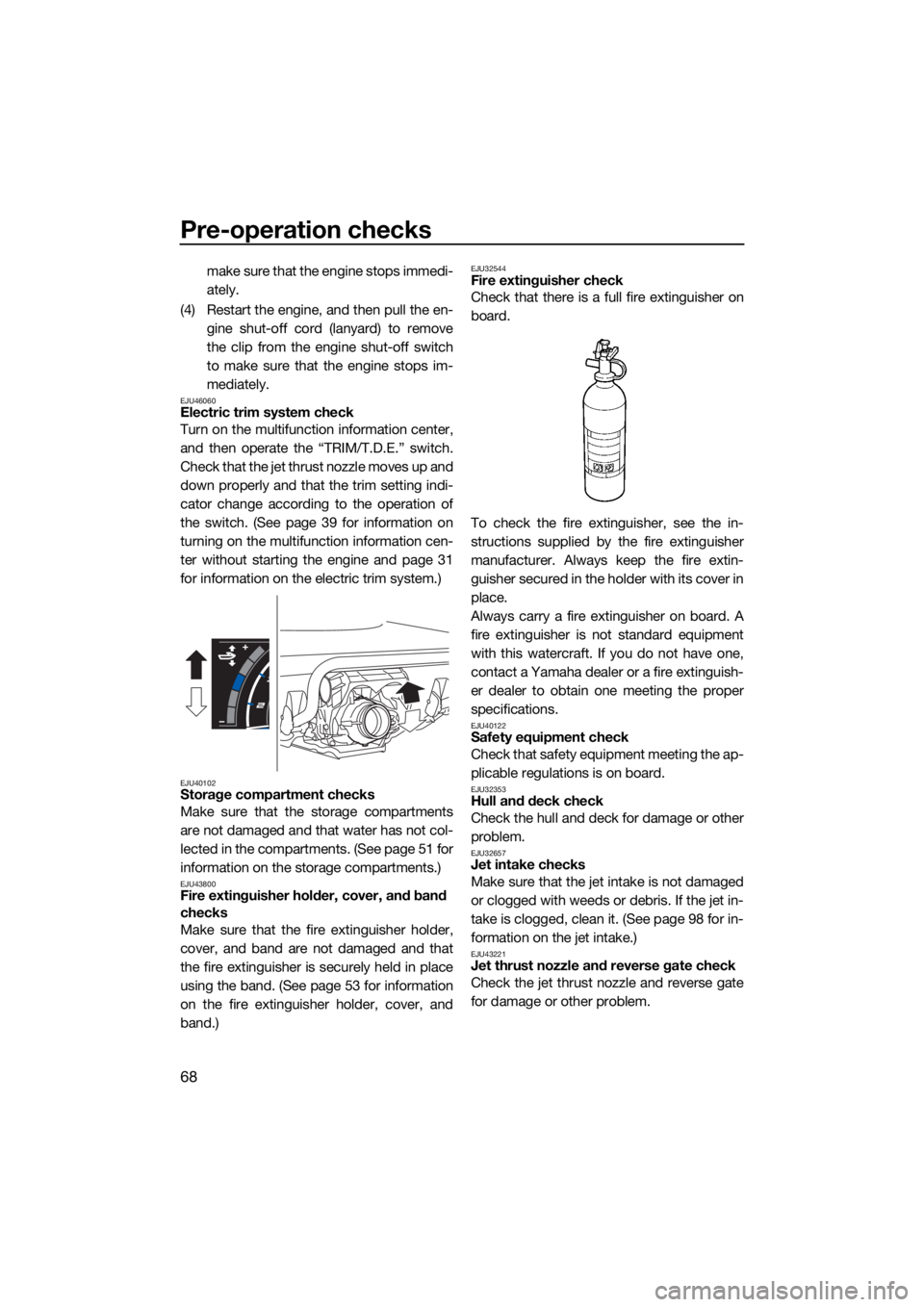
Pre-operation checks
68
make sure that the engine stops immedi-
ately.
(4) Restart the engine, and then pull the en- gine shut-off cord (lanyard) to remove
the clip from the engine shut-off switch
to make sure that the engine stops im-
mediately.
EJU46060Electric trim system check
Turn on the multifunction information center,
and then operate the “TRIM/T.D.E.” switch.
Check that the jet thrust nozzle moves up and
down properly and that the trim setting indi-
cator change according to the operation of
the switch. (See page 39 for information on
turning on the multifunction information cen-
ter without starting the engine and page 31
for information on the electric trim system.)
EJU40102Storage compartment checks
Make sure that the storage compartments
are not damaged and that water has not col-
lected in the compartments. (See page 51 for
information on the storage compartments.)
EJU43800Fire extinguisher holder, cover, and band
checks
Make sure that the fire extinguisher holder,
cover, and band are not damaged and that
the fire extinguisher is securely held in place
using the band. (See page 53 for information
on the fire extinguisher holder, cover, and
band.)
EJU32544Fire extinguisher check
Check that there is a full fire extinguisher on
board.
To check the fire extinguisher, see the in-
structions supplied by the fire extinguisher
manufacturer. Always keep the fire extin-
guisher secured in the holder with its cover in
place.
Always carry a fire extinguisher on board. A
fire extinguisher is not standard equipment
with this watercraft. If you do not have one,
contact a Yamaha dealer or a fire extinguish-
er dealer to obtain one meeting the proper
specifications.
EJU40122Safety equipment check
Check that safety equipment meeting the ap-
plicable regulations is on board.
EJU32353Hull and deck check
Check the hull and deck for damage or other
problem.
EJU32657Jet intake checks
Make sure that the jet intake is not damaged
or clogged with weeds or debris. If the jet in-
take is clogged, clean it. (See page 98 for in-
formation on the jet intake.)
EJU43221Jet thrust nozzle and reverse gate check
Check the jet thrust nozzle and reverse gate
for damage or other problem.
UF4P72E0.book Page 68 Tuesday, August 24, 2021 3:18 PM